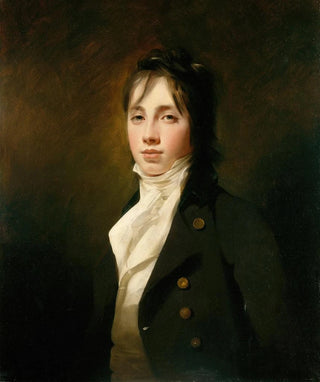Art print | William Fraser de Reelig 1784-1835 - Sir Henry Raeburn


View from behind

Frame (optional)
William Fraser of Reelig 1784-1835 - Sir Henry Raeburn – Engaging Introduction
The painting "William Fraser of Reelig 1784-1835" by Sir Henry Raeburn is much more than a simple depiction of a man in period attire. This artwork embodies a specific era, a place, and a personality, while also revealing the technical mastery and emotion that characterize Raeburn's work. By contemplating this piece, the viewer is transported to early 19th-century Scotland, a period marked by social and political upheavals. William Fraser, a respected businessman and philanthropist, is captured here in a moment of reflection, offering a fascinating glimpse into his character and his social standing of the time.
Style and uniqueness of the work
Raeburn's style is often described as a harmonious blend of realism and romanticism, and this piece is no exception. The composition is carefully balanced, with flowing lines guiding the viewer’s gaze. The lighting, subtle and controlled, accentuates Fraser's facial features, revealing a psychological depth that transcends a simple portrait. The color palette, rich and nuanced, evokes an atmosphere that is both solemn and warm. This play of light and color demonstrates Raeburn's ability to capture not only the physical appearance of his subjects but also their inner essence. Every detail, from the draping of clothing to the expression in the eyes, is treated with meticulous care that invites prolonged contemplation.
The artist and his influence
Sir Henry Raeburn, an iconic figure in Scottish portraiture, established himself as one of the most influential painters of his time. Trained in the art of painting through travels across Europe, he mastered the techniques of old masters while developing a personal style unique to himself. Raeburn was a pioneer in how he approached his subjects, going beyond mere portraiture to explore themes of personality and identity. His influence extends well beyond his contemporaries, inspiring generations of artists who followed in his footsteps. The way he captured the human soul in his portraits continues to be a benchmark in the art world.

Matte finish

View from behind

Frame (optional)
William Fraser of Reelig 1784-1835 - Sir Henry Raeburn – Engaging Introduction
The painting "William Fraser of Reelig 1784-1835" by Sir Henry Raeburn is much more than a simple depiction of a man in period attire. This artwork embodies a specific era, a place, and a personality, while also revealing the technical mastery and emotion that characterize Raeburn's work. By contemplating this piece, the viewer is transported to early 19th-century Scotland, a period marked by social and political upheavals. William Fraser, a respected businessman and philanthropist, is captured here in a moment of reflection, offering a fascinating glimpse into his character and his social standing of the time.
Style and uniqueness of the work
Raeburn's style is often described as a harmonious blend of realism and romanticism, and this piece is no exception. The composition is carefully balanced, with flowing lines guiding the viewer’s gaze. The lighting, subtle and controlled, accentuates Fraser's facial features, revealing a psychological depth that transcends a simple portrait. The color palette, rich and nuanced, evokes an atmosphere that is both solemn and warm. This play of light and color demonstrates Raeburn's ability to capture not only the physical appearance of his subjects but also their inner essence. Every detail, from the draping of clothing to the expression in the eyes, is treated with meticulous care that invites prolonged contemplation.
The artist and his influence
Sir Henry Raeburn, an iconic figure in Scottish portraiture, established himself as one of the most influential painters of his time. Trained in the art of painting through travels across Europe, he mastered the techniques of old masters while developing a personal style unique to himself. Raeburn was a pioneer in how he approached his subjects, going beyond mere portraiture to explore themes of personality and identity. His influence extends well beyond his contemporaries, inspiring generations of artists who followed in his footsteps. The way he captured the human soul in his portraits continues to be a benchmark in the art world.






